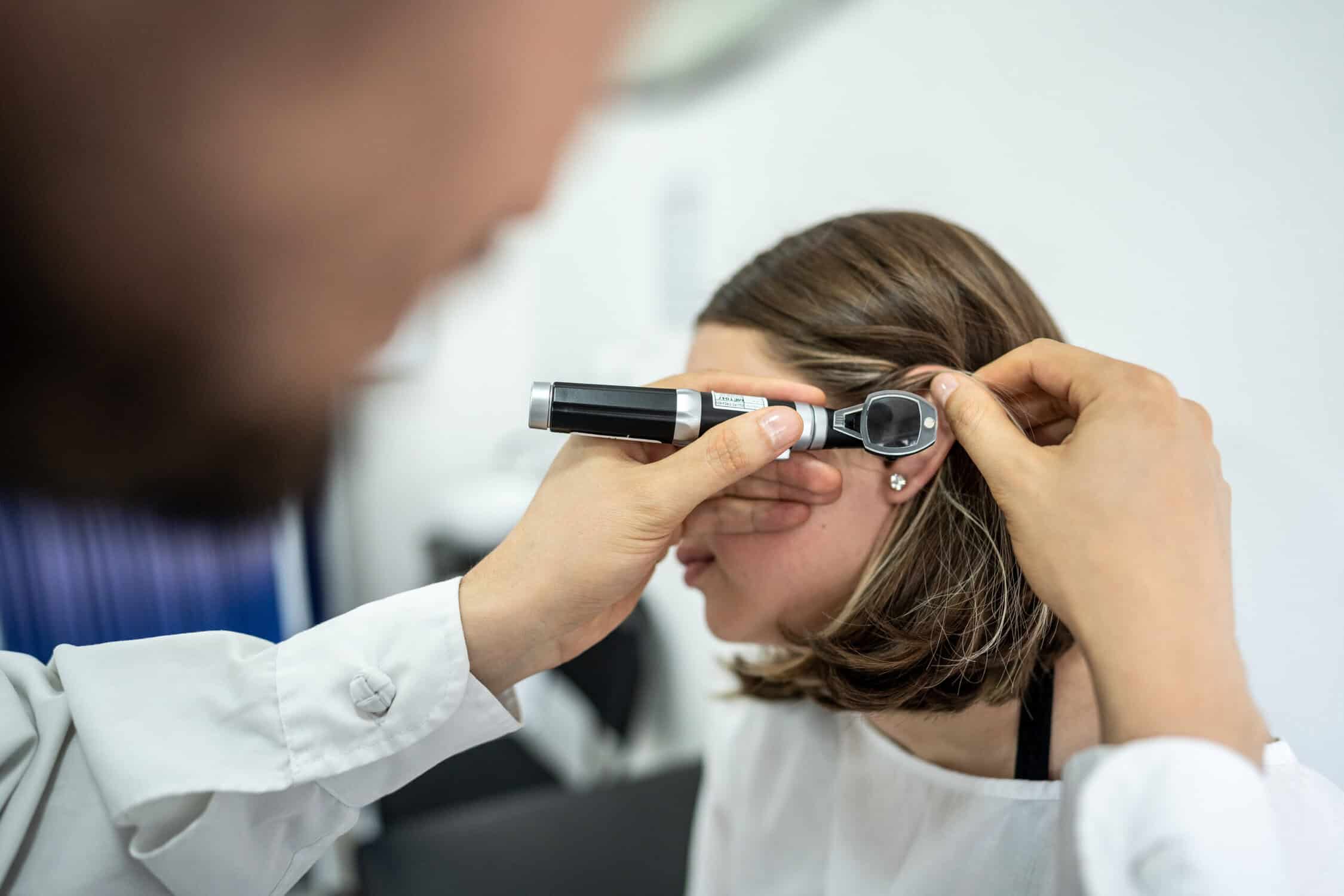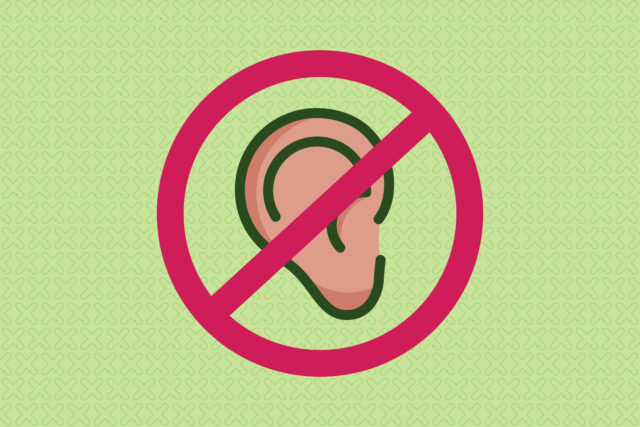
Ear wax removal services are essential and around 2.3 million people in the UK need professional ear wax removal every year. Our research shows that too many people are not able to get their ear wax professionally removed. As a result, people face painful symptoms, limited audiology care, and mental health challenges.
A vital service withdrawn
A lack of consistent NHS ear wax removal services, particularly as many GP surgeries no longer offer this service, leaves people with few options. Private removal, often costing up to £100, is unaffordable for many. Attempting self-removal can lead to serious complications, such as infections, permanent damage to the ear or hearing loss.
There is no medical reason for withdrawing this vital service. The ongoing cuts to ear wax removal services are having a profound impact on people’s wellbeing.
Read more about the symptoms of ear wax build up.

Take action now
Your stories
A postcode lottery
Availability of NHS ear wax removal must be based on need, not location or ability to pay. Our new report has exposed a serious lack of progress on the availability of ear wax services in England, leaving 8.1 million with zero support and at risk of preventable hearing loss.
Failing to offer free NHS wax removal services contradicts clear guidance from the National Institute of Health and Care Excellence (NICE) – the body that recommends which services should be available on the NHS.
NICE guidelines state that GP surgeries or community clinics should offer to remove ear wax, if build-up is contributing to someone’s hearing loss or causing other symptoms.

Take a look at our regional map of services
The campaign so far…
In January 2024, we published our research report, Blocked Ears, Blocked Access: the Crisis of NHS Ear Wax Removal in England. This highlighted the postcode lottery of ear wax removal services in Integrated Care Board (ICBs) across England.
Back then, less than half of ICBs met the NICE guidelines, which state that wax removal should be offered on the NHS if there is a medical need.
Thanks to our amazing supporters, over 1,000 emails were sent to local newspapers last year, calling for the provision of wax removal services in their areas and urging the government to review NHS services. Your efforts generated a huge wave of interest, resulting in extensive press coverage and a significant swell of people speaking out about the importance of this issue. Thank you for making such an incredible impact.
In November 2024, we submitted another round of Freedom of Information requests to ICBs in England. Thanks to our campaigning efforts, helped by people like you, we have seen slight improvements in certain areas of England – more than half (23) of ICBs now offer a full wax removal service, 13 commission a partial service across some of their area, and 6 still don’t commission a service.
Many of the areas not fully commissioning told us they are conducting a review of services. Whilst this shows a positive step, progress has been slow – it isn’t enough, so we will continue to keep the pressure on and ensure everyone who has a medical need for professional ear wax removal can access it locally through an NHS service, when they need it.
Welsh Government has published guidance for ear wax management services across the country. This was first issued in 2020 and states that a free NHS service should be available in primary and community care, in line with what we are campaigning for. But, almost five years on, we know that there are still significant and extremely concerning gaps in this service.
We have published our Stop the Block report for Wales, revealing how much further there is to go to achieve a consistent NHS wax management service in Wales. Our research, based on Freedom of Information requests to Wales’ seven health boards, reveals that roughly half the population still do not have access to a service in line with Welsh Government’s guidance. Three health boards provide a wax management service. Two have a partial service in place – meaning wax management is available in parts of the health board area. Two health boards have no service available at all. This means that an estimated 48,000 people who require wax removal are still left without access to a service.
This is not good enough. We are calling for Welsh Government to ensure that all health boards urgently act to ensure a wax management service is in place in all parts of Wales. We want Welsh Government to work with health boards to achieve this and ensure that specific funding is made available to meet the standards set out in 2020, as soon as possible.
The Scottish Government have confirmed to Scottish Health Boards that ear wax removal should be provided by local Community Treatment and Care (CTAC) services.
We received responses from 14 health boards to Freedom of Information requests to establish an updated picture on what wax management services are commissioned across Scotland.
In the last year, we’ve seen an improvement in ear wax removal service coverage in Scotland. Eleven health boards responded that ear wax removal is fully available to all adults in primary or community care services, in line with professional guidance. Two health boards said that wax removal is partially available in some but not all parts of the area they cover.
Only Orkney Health Board does not commission a wax removal service in primary or community care, but this is because of its small and remote population- ear wax removal services are delivered in an outpatient setting by a visiting Ear, Nose and Throat (ENT) consultant.
We have worked closely with the Scottish Government and welcome their commitment to put in place a Scotland wide training programme, that will seek to resolve the skills gap and help reduce access variation in relation to ear wax removal. We will continue to monitor the impact of this initiative.
People in NI are being told that the service is no longer provided in primary care and, if they are lucky, referred to a service in hospital.
This is an inefficient use of GP and audiologists time, as well as being inconvenient for the patient. Even worse, many patients are not being referred and told to seek paid private treatment.
Our campaign goals
Ear wax removal is a vital service to support people’s quality of life. We believe everyone with a medical need for wax removal service should have free access to it, when they need it.
RNID is calling for:
- NHS England to provide guidance to Integrated Care Boards (ICBs) and work with them on implementation to provide free ear wax removal services to NHS patients in primary care and community settings, in line with NICE guidance. RNID will continue to work with the Scottish and Welsh governments to ensure they also work with their health boards in this way.
- NHS England to publish improved patient information on the self-management of ear wax.
- Commissioners to ensure their ear wax removal providers are meeting contractual obligations, and that patient-facing staff are aware of what services are available to who.
- NHS England to ensure that GP surgeries and ICBs share consistent, safe and evidence-based information about ear wax removal and self-management with their patients.
In our recent survey you told us…
73% of you
believe ear wax removal should be free for everyone through the NHS.
Two in five
of you told us that you cannot afford private ear wax removal, which typically costs £55-£100.
62% of you
told us that you think this cost is unreasonable.
Read our reports on ear wax removal services
Our previous research
In January 2024, our ear wax removal campaign took the press by storm, as our new research revealed the postcode lottery faced by people in the UK who need NHS ear wax removal services.
We published our Blocked ears, Blocked Access report and survey findings to raise awareness of the postcode lottery facing people in England with ear wax build up, revealed through our Freedom of Information (FOI) data, and focused on the distressing symptoms that wax build up can cause.
Between September 2024 and November 2024 we submitted a new set of FOI requests to ICBs in England, and health bodies in Scotland and Wales.
In December 2024, we conducted public polling with Censuswide to understand more about the experiences of people who needed ear wax removal by a healthcare professional, our findings from responders showed that of those people who have had professional wax removal, 32% said oil/drops were unsuccessful.
From August 2023 to November 2023, we submitted FOI requests to all 42 ICBs in England, the commissioners of most NHS services.
Of the 40 that replied, only 18 said they fully commission wax removal services in line with NICE guidelines, 15 partially commission services (for example providing a service in some towns but not others). Seven ICBs don’t commission services at all, leaving almost 10 million people completely without access on the NHS if they should need it.
We know that because people are unable to access the service on the NHS, they are attempting to manage ear wax build up themselves, sometimes on the advice of a healthcare professional, such a doctor, nurse or pharmacist.
However, recommendations around self-management don’t seem to be consistent and are not widely shared.
In the summer of 2022, we ran a survey to find out more about what advice you are getting on self-management, what action you are taking, and what has happened afterwards.
1,491 of you responded and we found that:
- 73% of respondents with ear wax build-up experienced hearing loss, and 37% experienced tinnitus. Half of respondents experienced earache or discomfort, and a quarter experienced dizziness.
- More than a quarter of survey respondents could not afford to get their ear wax removed privately, which can cost between £50-£100.This was especially problematic for hearing aid wearers, who need ear wax removed more regularly.
- Cost for private treatment and long waits for ear wax removal at hospital led many respondents to attempt to remove ear wax themselves, although two thirds did not feel confident doing this.
- Many of the methods people described to remove ear wax were dangerous, including hair clips, paper clips, toothpicks, cotton buds, and Hopi ear candles.
- After trying to remove ear wax themselves, only 20% of respondents said their problems went away, whilst 55% of people noticed no change in their condition. 1 in 10 said their symptoms got worse, or they caused themselves injury which required medical attention.
In 2021 we asked you what problems you had faced and where.
We received nearly 1,400 responses, with the majority of you telling us you were told to have your ear wax removed privately, or simply that this service was not provided on the NHS in your area. Nearly 100 people were also told to remove their ear wax themselves.
Your responses also helped us to identify where the problems were worse, and we sent Freedom of Information requests to the worst performing Clinical Commissioning Groups (CCGs – now replaced by ICBs), to find out more about their procedures on the removal of wax.
We did this to help us understand if the issue is:
- CCGs not including wax removal as a Locally Enhanced Service
- providers (such as GPs) being unaware of this
- or providers choosing not to provide the service.
Unfortunately, the responses we received didn’t give us the answers we need. Often, CCGs told us that they didn’t hold the information.


